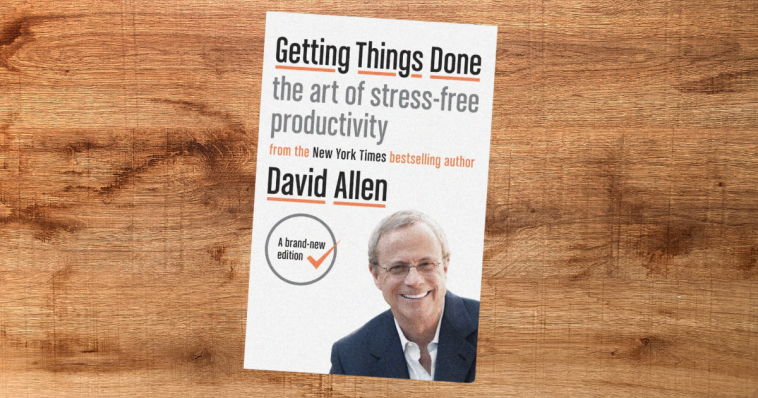The constant influx of tasks and deadlines can quickly feel overwhelming in today’s fast-paced world. Many people seek methods to streamline their lives and better manage their time. One such method is Getting Things Done (GTD), a productivity system created by David Allen. GTD provides a structured approach to managing tasks, focusing on reducing mental clutter and increasing efficiency. Since its release in 2001, the system has become a cornerstone of productivity. Many people widely recognize it for helping individuals stay organized and focused amidst the chaos of daily life. This blog will explore the principles of GTD, its benefits, potential drawbacks, and whether it lives up to its reputation.
About the Book
Author’s Background and Expertise
David Allen, the author of Getting Things Done (GTD), is a highly regarded productivity consultant with extensive experience in the field. Over the years, he has worked with various clients, including executives, entrepreneurs, and creative professionals, helping them streamline their lives and improve efficiency. His practical insights and strategies are rooted in real-world applications, making his advice particularly valuable.
Allen’s work spans personal and professional productivity, aiming to create systems that reduce stress and boost effectiveness. With decades of experience, he has developed a reputation as one of the leading experts in time management and productivity. His strong reputation in the field convinces millions worldwide to adopt the GTD method. Allen’s focus on simplicity and clarity has made GTD a practical solution for those seeking to control their tasks and goals.
Core Principles of Getting Things Done
In Getting Things Done, David Allen outlines five core principles to help individuals manage tasks and reduce mental clutter. Capture’s first principle emphasizes collecting every task, idea, or reminder into a trusted system to clear your mind. Clarify comes next, where each item is processed to determine what action, if any, is required. Organizing is about categorizing tasks into lists such as “Next Actions” and “Projects,” making prioritizing and managing them more accessible.
Regular Reflection ensures that the system stays up-to-date, with weekly reviews helping individuals track progress and reassess priorities. The final principle, Engage, encourages individuals to take action on tasks they have already organized and clarified, enabling efficient execution. These five principles create a streamlined approach to managing work and personal responsibilities, reducing stress, and enhancing productivity.
Comparison to Other Time Management Methods
Getting Things Done shares similarities with other time management systems but has distinct features that set it apart. For example, the Pomodoro Technique encourages short, intense bursts of focused work followed by breaks, contrasting with GTD’s comprehensive system that addresses all aspects of life. Another popular method, the Eisenhower Matrix, helps prioritize tasks by dividing them based on urgency and importance.
Still, GTD focuses on creating a workflow that minimizes the need for constant decision-making. While both methods emphasize task prioritization, GTD’s system offers a more holistic approach, allowing users to regularly review tasks and adjust as needed. Unlike the Eisenhower Matrix, GTD doesn’t require users to constantly assess whether a task is urgent or essential; instead, it relies on a continual review process that keeps tasks organized.
GTD also differs from methods like the Pomodoro Technique by offering a more flexible system that doesn’t rely on time intervals but on consistent task management. GTD’s structured yet adaptable system suits various work styles and environments.
Why You Should Consider GTD?
GTD is a powerful productivity method that can help individuals take control of their tasks and enhance their efficiency. These are the reasons why you should consider this book.
1. Benefits of Implementing GTD
GTD offers several powerful benefits that can improve your personal and professional life. People praise it for boosting productivity, reducing stress, and enhancing focus, making it an attractive choice for those aiming to optimize their time and energy.
- Increased Productivity: One of the most frequently cited benefits of GTD is its ability to increase productivity. By capturing everything into a trusted system, you clear mental space, allowing you to focus on the tasks that truly matter. By providing a clear framework, this method enables individuals to maintain focus and manage tasks effectively, preventing feelings of overwhelm and fostering greater productivity. With less cognitive load, you can dive deeper into tasks rather than juggle multiple distractions simultaneously. Ultimately, this leads to faster completion of projects and a more effective work routine.
- Reduced Stress: GTD is also known for its stress-reducing effects. Breaking tasks into manageable chunks and regularly reviewing them creates a sense of control. This organization reduces the anxiety that often stems from disorganization and the fear of forgetting important tasks. GTD’s clarity makes individuals feel more confident about meeting deadlines and handling responsibilities. By reducing mental clutter, GTD offers a sense of calm and focus, easing the pressure many feel in today’s busy world.
- Improved Focus: Another critical benefit of GTD is enhanced focus. Breaking down tasks into specific, manageable actions simplifies progress tracking and minimizes the likelihood of getting sidetracked. This focused approach enables more deliberate and consistent progress toward achieving goals. Since tasks are clearly defined and categorized, you’ll likely save time deciding what to do next. GTD also helps reduce the urge to multitask, leading to better attention on the task at hand and more effective use of time.
2. Research Supporting the Positive Impact of GTD
Research has demonstrated that task management systems like GTD can positively influence cognitive function and mental well-being. Studies have shown that individuals using GTD report significant improvements in focus, reduced stress, and enhanced clarity when making decisions. Regularly reviewing and organizing tasks helps shift people from a reactive mindset to a more proactive one, allowing them to handle responsibilities more efficiently. Maintaining an organized system enables users to approach tasks with a clear and focused mind, which is critical to long-term success. Overall, the structure provided by GTD encourages healthier mental habits and more effective decision-making.
3. Testimonials from Successful Individuals
Many successful individuals, from corporate leaders to entrepreneurs and creative professionals, have publicly endorsed Getting Things Done (GTD) for its impact on productivity. For example, authors and speakers like Tim Ferriss and Merlin Mann have integrated GTD into their daily routines, crediting it as a game-changer in managing their tasks and time. These high achievers often juggle numerous projects, responsibilities, and deadlines, and they attribute their ability to stay on top of everything to the structured approach GTD offers. By eliminating mental chaos, the system empowers individuals to concentrate on their priorities with clarity and ease, free from feeling overwhelmed. GTD’s effectiveness in streamlining task management has made it a trusted method among those with demanding schedules.
These testimonials underscore the real-world effectiveness of GTD, especially for individuals working in dynamic, fast-paced environments. GTD’s structured approach creates a sense of order amidst competing priorities and fluctuating demands. The system enables users to simplify intricate tasks into smaller, achievable components, offering a sense of direction even in highly complex scenarios. The system’s adaptability and organization are especially valuable for those who regularly navigate shifting deadlines and responsibilities. These successful individuals attest that GTD improves task management and supports overall mental clarity and productivity.
Is GTD for everyone?
Despite its many benefits, Getting Things Done has its challenges. It is essential to acknowledge some of the criticisms and challenges people face when adopting the system.
1. Complexity and Learning Curve
One of the most significant criticisms of Getting Things Done (GTD) is its complexity. The intricate system requires individuals to follow numerous lists, categories, and processes. For those new to GTD, understanding and implementing all five core principles can be overwhelming. Setting up the system demands a substantial investment of time and effort, as it involves capturing and organizing everything that requires attention. The sheer volume of rules and guidelines to remember can make it challenging to stay focused and maintain the system consistently.
2. Time Investment Required for Maintenance
Maintaining a GTD system is an ongoing process, not a one-time setup. The weekly review, in particular, is essential to ensure that the system remains up-to-date and that you stay on track with your projects. However, this regular upkeep requires a significant time investment. For individuals with already packed schedules, dedicating time to maintaining the system can feel like an added burden, distracting from other priorities and responsibilities. This constant need for attention to detail can be draining and might only be feasible for some.
3. Risk of Micromanagement and Over-Planning
Another potential drawback of GTD is the risk of micromanagement. Because GTD encourages users to break tasks into the most minor possible actions and meticulously organize them, some people can become bogged down in over-planning. It can lead to analysis paralysis, where too much time is spent reviewing and organizing tasks instead of completing them. It can also reduce flexibility, making it difficult to adapt to changing circumstances and unexpected tasks.
4. Criticism from Other Productivity Experts
Some productivity experts argue that GTD is too rigid and doesn’t allow enough room for flexibility. They believe a more relaxed approach to task management might be more appropriate, particularly for those in creative fields or fast-paced industries where strategic thinking and big-picture planning are essential. Others criticize GTD for its heavy focus on tasks and actions, arguing that it can overlook the importance of higher-level thinking and vision. These critiques suggest that the system might need to be more adaptable for all work environments and individual styles.
Is GTD Right for You?
Getting Things Done (GTD) can be an effective productivity system for those willing to invest the time and effort into setting it up and maintaining it. Its structured approach helps users increase productivity, reduce stress, and focus on what truly matters. For individuals who thrive on organization, GTD’s clear principles can provide a sense of clarity and control.
However, it’s essential to consider its drawbacks, such as the system’s complexity and the time required to keep it running. If not managed properly, the risk of over-planning and micromanagement can also impede progress. If you try GTD, it’s best to experiment with and tailor the system to fit your needs and work style. GTD may only work for some, so finding the right balance is critical.



